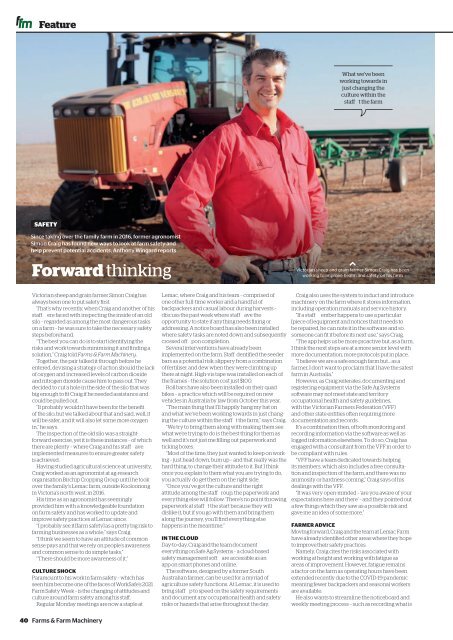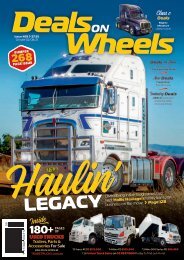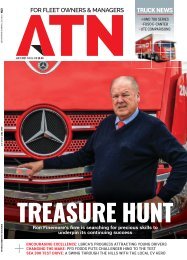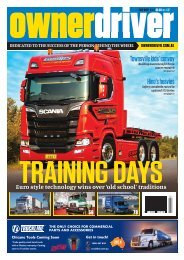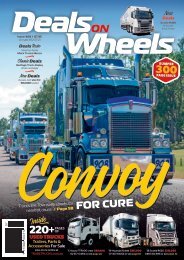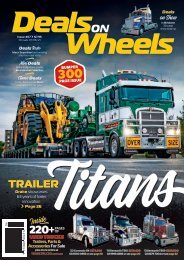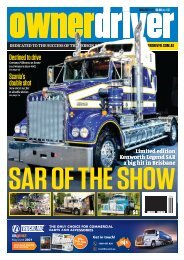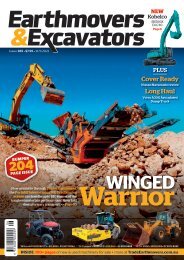Farms & Farm Machinery #401
Create successful ePaper yourself
Turn your PDF publications into a flip-book with our unique Google optimized e-Paper software.
Feature<br />
What we’ve been<br />
working towards in<br />
just changing the<br />
culture within the<br />
staff t the farm<br />
SAFETY<br />
Since taking over the family farm in 2016, former agronomist<br />
Simon Craig has found new ways to look at farm safety and<br />
help prevent potential accidents, Anthony Wingard reports<br />
Forward thinking<br />
Victorian sheep and grain farmer Simon Craig has been<br />
working to improve health and safety on his farm<br />
Victorian sheep and grain farmer Simon Craig has<br />
always been one to put safety first.<br />
That’s why recently, when Craig and another of his<br />
staff ere faced with inspecting the inside of an old<br />
silo – regarded as among the most dangerous tasks<br />
on a farm – he was sure to take the necessary safety<br />
steps beforehand.<br />
“The best you can do is to start identifying the<br />
risks and work towards minimising it and finding a<br />
solution,” Craig told <strong><strong>Farm</strong>s</strong> & <strong>Farm</strong> <strong>Machinery</strong>.<br />
Together, the pair talked it through before he<br />
entered, devising a strategy of action should the lack<br />
of oxygen and increased levels of carbon dioxide<br />
and nitrogen dioxide cause him to pass out. They<br />
decided to cut a hole in the side of the silo that was<br />
big enough to fit Craig if he needed assistance and<br />
could be pulled out.<br />
“It probably wouldn’t have been for the benefit<br />
of the silo, but we talked about that and said, well, it<br />
will be safer, and it will also let some more oxygen<br />
in,” he says.<br />
The inspection of the old silo was a straightforward<br />
exercise, yet it is these instances – of which<br />
there are plenty – where Craig and his staff ave<br />
implemented measures to ensure greater safety<br />
is achieved.<br />
Having studied agricultural science at university,<br />
Craig worked as an agronomist at ag-research<br />
organisation Birchip Cropping Group until he took<br />
over the family’s Lemac farm, outside Kooloonong<br />
in Victoria’s north west, in 2016.<br />
His time as an agronomist has seemingly<br />
provided him with a knowledgeable foundation<br />
on farm safety and has worked to update and<br />
improve safety practices at Lemac since.<br />
“I probably see it [farm safety] as a pretty big risk to<br />
farming businesses as a whole,” says Craig.<br />
“I think we seem to have an attitude of common<br />
sense pays and that we rely on people’s awareness<br />
and common sense to do simple tasks,”<br />
“There should be more awareness of it.”<br />
CULTURE SHOCK<br />
Paramount to his work in farm safety – which has<br />
seen him become one of the faces of WorkSafe’s 2021<br />
<strong>Farm</strong> Safety Week – is the changing of attitudes and<br />
culture around farm safety among his staff.<br />
Regular Monday meetings are now a staple at<br />
Lemac, where Craig and his team – comprised of<br />
one other full-time worker and a handful of<br />
backpackers and casual labour during harvests –<br />
discuss the past week where staff ave the<br />
opportunity to state if anything needs fixing or<br />
addressing. A notice board has also been installed<br />
where safety tasks are noted down and subsequently<br />
crossed off pon completion.<br />
Several interventions have already been<br />
implemented on the farm. Staff dentified the seeder<br />
bars as a potential risk; slippery from a combination<br />
of fertiliser and dew when they were climbing up<br />
there at night. High-vis tape was installed on each of<br />
the frames – the solution cost just $100.<br />
Roll bars have also been installed on their quad<br />
bikes – a practice which will be required on new<br />
vehicles in Australia by law from October this year.<br />
“The main thing that I’ll happily hang my hat on<br />
and what we’ve been working towards in just changing<br />
the culture within the staff t the farm,” says Craig.<br />
“We try to bring them along with making them see<br />
what we’re trying to do is the best thing for them as<br />
well and it’s not just me filling out paperwork and<br />
ticking boxes.<br />
“Most of the time, they just wanted to keep on working<br />
– just head down, bum up – and that really was the<br />
hard thing, to change their attitude to it. But I think<br />
once you explain to them what you are trying to do,<br />
you actually do get them on the right side.<br />
“Once you’ve got the culture and the right<br />
attitude among the staff roup, the paperwork and<br />
everything else will follow. There’s no point throwing<br />
paperwork at staff t the start because they will<br />
dislike it, but if you go with them and bring them<br />
along the journey, you’ll find everything else<br />
happens in the meantime.”<br />
IN THE CLOUD<br />
Day-to-day, Craig and the team document<br />
everything on Safe Ag Systems – a cloud-based<br />
safety management soft are accessible as an<br />
app on smart phones and online.<br />
The software, designed by a former South<br />
Australian farmer, can be used for a myriad of<br />
agriculture safety functions. At Lemac, it is used to<br />
bring staff p to speed on the safety requirements<br />
and document any occupational health and safety<br />
risks or hazards that arise throughout the day.<br />
Craig also uses the system to induct and introduce<br />
machinery on the farm where it stores information,<br />
including operation manuals and service history.<br />
“If a staff ember happens to use a particular<br />
[piece of] equipment and notices that it needs to<br />
be repaired, he can note it in the software and so<br />
someone can fit it before its next use,” says Craig.<br />
“The app helps us be more proactive but, as a farm,<br />
I think the next steps are at a more senior level with<br />
more documentation, more protocols put in place.<br />
“I believe we are a safe enough farm but… as a<br />
farmer, I don’t want to proclaim that I have the safest<br />
farm in Australia.”<br />
However, as Craig reiterates, documenting and<br />
registering equipment via the Safe Ag Systems<br />
software may not meet state and territory<br />
occupational health and safety guidelines,<br />
with the Victorian <strong>Farm</strong>ers Federation (VFF)<br />
and other state entities often requiring more<br />
documentation and records.<br />
It’s a combination then, of both monitoring and<br />
recording information via the software as well as<br />
logged information elsewhere. To do so, Craig has<br />
engaged with a consultant from the VFF in order to<br />
be compliant with rules.<br />
“VFF have a team dedicated towards helping<br />
its members, which also includes a free consultation<br />
and inspection of the farm, and there was no<br />
animosity or hardness coming,” Craig says of his<br />
dealings with the VFF.<br />
“It was very open-minded – ‘are you aware of your<br />
expectations here and there’ – and they pointed out<br />
a few things which they saw as a possible risk and<br />
gave me an idea of some more.”<br />
FARMER ADVICE<br />
Moving forward, Craig and the team at Lemac <strong>Farm</strong><br />
have already identified other areas where they hope<br />
to improve their safety practices.<br />
Namely, Craig cites the risks associated with<br />
working at height and working with fatigue as<br />
areas of improvement. However, fatigue remains<br />
a factor on the farm as operating hours have been<br />
extended recently due to the COVID-19 pandemic<br />
meaning fewer backpackers and seasonal workers<br />
are available.<br />
He also wants to streamline the noticeboard and<br />
weekly meeting process – such as recording what is<br />
40 <strong><strong>Farm</strong>s</strong> & <strong>Farm</strong> <strong>Machinery</strong>


